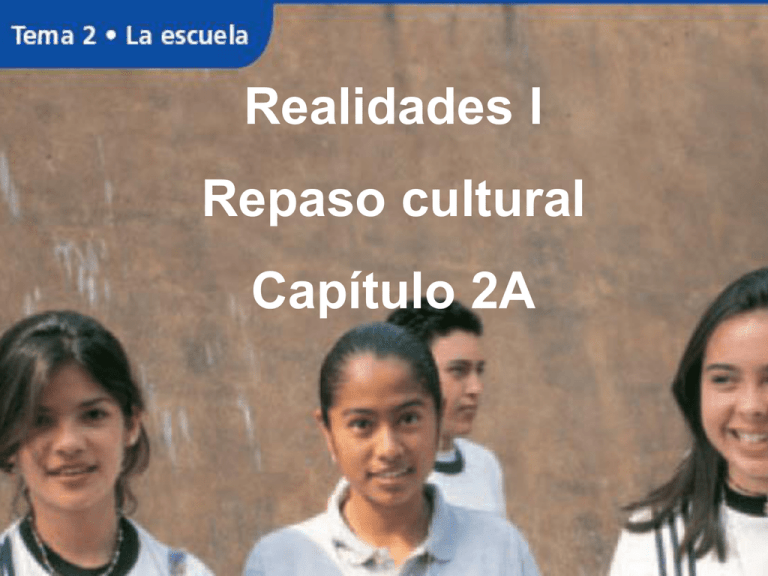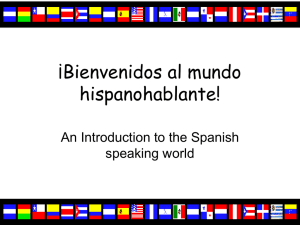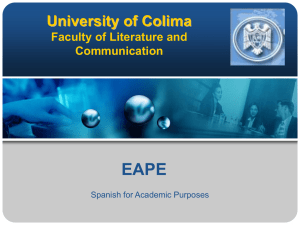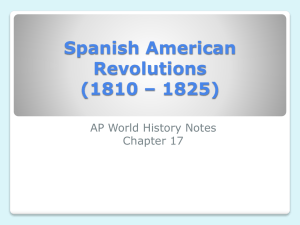Culture 2A - Bienvenidos a las clases de la Sra. Mardos
advertisement

Realidades I Repaso cultural Capítulo 2A Fernando Botero • Colombian artist Fernando Botero (1932– ) is among the best known and most respected Latin American artists. His works have been exhibited around the world in prestigious museums, galleries, and openair places. Botero’s style is unique and recognizable. Pedrito Botero, shown in the painting, was the artist’s son. He died in a car accident when he was four years old. • Based upon the painting, how could you describe Botero’s style? Studying English? • • While you’re in Spanish class at your school, large numbers of Spanish-speaking students are studying to learn the most popular foreign language worldwide: English. Many children begin to study English in grade school and continue through high school. They often attend special language school for additional English classes. When visiting a Spanish-speaking country, you might easily find someone who is eager to practice his or her English skills with you in exchange for helping you improve your Spanish. Why do you think English is so popular in other countries? Are you studying Spanish for similar reasons? Exploración del lenguaje Connections between Latin, English, and Spanish • Many words in English and Spanish are based on Latin. Seeing the relationship between these words will help expand your English or Spanish vocabulary. Look at the list of Latin root forms for the numbers 1 to 10. • Try it out! For each Roman numeral listed, choose one of the root forms (if more than one is listed) and write down a Spanish or English word you know that is based on that root. • Try it out! The Roman year used to begin with the month of March. Knowing that, can you explain why septiembre, octubre, noviembre, and diciembre use the Latin root forms for seven, eight, nine, and ten? El aqueducto de Segovia, España • Many Spanish words are derived from Latin because Spain was once part of the Roman Empire. Rome occupied most of Spain from about 209 B.C. to 586 A.D. During that time, massive public structures, including aqueducts and theaters, were built. Some of these, such as the aqueduct that towers over the modern city of Segovia, are still standing. The Latin name for Spain was Hispania. • Can you see the similarity between Hispania and the country’s name in Spanish, España? El recreo • In Spanish-speaking countries, students usually have el recreo (recess or break) in the school patio. Students take time to relax and spend time with friends, eat a snack, or participate in activities such as a quick game of basketball, soccer, or volleyball. • How is this similar to your school? How is it different? Conexiones Las matemáticas • The Maya used three symbols to write numbers: a dot • a bar — and a drawing of a shell. The dot equals 1, the bar equals 5, and the shell equals 0. Mayan numbers were written from bottom to top, not from left to right. • Look at the Mayan numbers below. What would these Mayan numbers be in our numbering system? 14 12 10 1. = _____ 2. * * * * = _____ 3. * * = _____ Now, write these numbers in the Mayan system below: 4. 13 = _* * *_ ______________________ 5. 16 = _ ___*____ _______________________ _______________________ 6. 19 = _ *_* * *__ _______________________ _______________________ Pronunciación The letter c • In Spanish the pronunciation of the letter c depends on the letter that follows it. When the letter c comes before a, o, u, or another consonant, it is pronounced like the c in “cat.” Listen to and say these words: computadora tampoco correr • escuela tocar Carlos When the letter c comes before e or i, most Spanish speakers pronounce it like the s in “Sally.” Listen to and say these words: veces hacer • cantar cómo practicar sociable once gracioso doce gracias trece Try it out! Listen to this rhyme. Listen particularly for the sound of the letter c. Then repeat the rhyme. Cero más cuatro, o cuatro más cero, siempre son cuatro. ¿No es verdadero? El español en la comunidad • Do you know about opportunities to learn Spanish in your community outside of your school? Do some research using the Internet, college brochures, and the Yellow Pages about Spanish classes or private lessons offered in your community. Make a list of your findings. Why do you think people in your community want to study Spanish? Spanish is becoming a very known language in the United States La Escuela Español Vivo ¡Adelante! ¡Una experiencia fabulosa en Costa Rica! ¡Estudia español con nosotros en la Escuela Español Vivo! Es verano, el mes de junio. Eres estudiante en Santa Ana, un pueblo en las montañas de Costa Rica. ¿Y cómo es una clase? Hay cinco estudiantes en tu clase. Uds. escuchan, hablan y practican el español todo el día. También usan la computadora. En la escuela hay estudiantes de muchos países: Estados Unidos, Inglaterra, Francia, Brasil, Canadá, Japón, India, Sudáfrica y otros. ¡Todos estudian español! sábados/domingos • visitar un volcán • visitar un parque nacional • nadar en el océano Pacífico El horario de clases en la escuela es: Hora lunes a viernes 08:00–10:30 Clases de español 10:30–11:00 Recreo 11:00–13:00 Clases de español 13:00–14:00 Almuerzo 14:00–15:30 Conversaciones 15:30–16:30 Clase de música y baile ¡6 horas cada día! La hora • La hora in Spanish-speaking countries is usually shown using the 24-hour clock on official schedules and timetables. Times in the morning are shown as 00:00 (midnight) through 11:59 (11:59 A.M.) • 1:00 P.M. is shown as 13:00, 2:00 P.M. is 14:00, and so on. • Look at the times in the horario from the train station. At what time does the train from Oerlikon arrive? 2:37 p.m. ¡Fútbol! • El fútbol (soccer) is the favorite sport in most Spanish-speaking countries. In fact, it is the most popular sport in the entire world. It has grown in popularity in the United States over the past years. As with other sports you are familiar with, fútbol has loyal fans, cheers, team songs, and sometimes cheerleaders. If you attended a game in Venezuela at the Escuela Secundaria Bolívar you might hear the following chant: Chiquitibúm a la bim bom bam A la bío A la bao A la bim bom bam ¡Bolívar! ¡Bolívar! ¡Ra, ra, ra! México • With a population of more than 100 million people, Mexico is the most populous Spanish-speaking country. • The Mayan city of Tulum, situated on a cliff overlooking the Caribbean, was a major port from about 1200 until the Spaniards arrived in the early 1500s. The Mayan civilization dates from 750 B.C., and includes ancient cities throughout southern Mexico, including the Yucatan Peninsula, and parts of Central America. • The butterfly reserve at El Rosario, Michoacán, lies in the mountains not far from Mexico City. From November through February every year, millions of monarch butterflies migrate to this area from the north, covering the branches of the area’s tall pine trees. • Mexico’s most famous dance company, el Ballet Folklórico de México, is a world-class troupe of more than 75 dancers and musicians. For more than five decades, this company has been touring the globe and performing traditional Mexican dances, such as the jarabe tapatío, (better known in the United States as the Mexican hat dance), la culebra, and the chilingo lingo. Más de México • Mexico’s capital is one of the largest cities in the world. It is also one of the oldest, dating back to 1500 B.C. It was here that the Aztecs built their capital, Tenochtitlán, in the 1300s. When the Spaniards arrived in 1519, Tenochtitlán had a population of more than 100,000 — making it larger than most European cities. • Many families in Mexico spend Sundays together. A popular spot for families in Mexico City is Xochimilco, where they can relax on colorful boats while enjoying a meal and music. The canals of Xochimilco are remnants of chinampas, the “floating gardens” that helped feed Tenochtitlán and other ancient cities in the valley of Mexico. ¡El fin!









